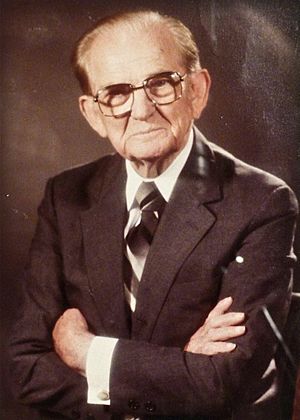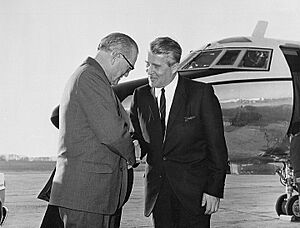John C. Stennis facts for kids
Quick facts for kids
John C. Stennis
|
|
|---|---|

Stennis in December 1984
|
|
| President pro tempore of the United States Senate | |
| In office January 3, 1987 – January 3, 1989 |
|
| Deputy | George J. Mitchell |
| Preceded by | Strom Thurmond |
| Succeeded by | Robert Byrd |
| Chair of the Senate Appropriations Committee | |
| In office January 3, 1987 – January 3, 1989 |
|
| Preceded by | Mark Hatfield |
| Succeeded by | Robert Byrd |
| Chair of the Senate Armed Services Committee | |
| In office January 3, 1969 – January 3, 1981 |
|
| Preceded by | Richard Russell |
| Succeeded by | John Tower |
| Chair of the Senate Standards Committee | |
| In office January 3, 1965 – January 3, 1975 |
|
| Preceded by | Position established |
| Succeeded by | Howard Cannon |
| United States Senator from Mississippi |
|
| In office November 5, 1947 – January 3, 1989 |
|
| Preceded by | Theodore Bilbo |
| Succeeded by | Trent Lott |
| Member of the Mississippi House of Representatives from the Kemper County district |
|
| In office January 1928 – January 1932 Serving with Joseph H. Daws
|
|
| Personal details | |
| Born |
John Cornelius Stennis
August 3, 1901 Kemper County, Mississippi, U.S. |
| Died | April 23, 1995 (aged 93) Jackson, Mississippi, U.S. |
| Political party | Democratic |
| Spouse | Coy Hines |
| Children | 2, including John |
| Education | Mississippi State University (BA) University of Virginia (LLB) |

John Cornelius Stennis (born August 3, 1901 – died April 23, 1995) was an American politician. He served as a U.S. Senator for Mississippi. Stennis was a Democrat. He served in the Senate for more than 41 years. For his last eight years, he was the most senior member of the Senate. He retired in 1989. He is the last Democrat to have been a U.S. Senator from Mississippi.
While studying law, Stennis was elected to the Mississippi House of Representatives. He held this office from 1928 to 1932. After working as a prosecutor and a state judge, Stennis won a special election to the U.S. Senate in 1947. He won a full term in 1952 and stayed in the Senate until 1988. Stennis became the first chairman of the Senate Ethics Committee. He also led the Committee on Armed Services and the Committee on Appropriations. From 1987 to 1989, he was the President pro tempore of the Senate.
Contents
Early Life and Education
John Stennis was born into a middle-class family in Kemper County, Mississippi. His parents were Hampton Howell Stennis and Margaret Cornelia Adams. His family came from Scotland.
He earned a bachelor's degree from Mississippi State University in 1923. In 1928, Stennis received a law degree from the University of Virginia. While in law school, he won a seat in the Mississippi House of Representatives. He represented Kemper County until 1932. Stennis worked as a prosecutor from 1932 to 1937. He then became a circuit judge from 1937 to 1947.
Important Court Case: Brown v. Mississippi
As a prosecutor, Stennis was involved in the case of Brown v. Mississippi (1936). In this case, three African American defendants had been forced to confess to a crime. The Supreme Court later ruled that using confessions gained through torture was illegal. This decision was a major step in protecting people's rights.
Stennis married Coy Hines. They had two children, John Hampton and Margaret Jane. His son, John Hampton Stennis, later became an attorney.
Serving in the U.S. Senate
Starting His Senate Career
After Senator Theodore Bilbo died in 1947, Stennis won a special election to fill the empty seat. He was elected for a full term in 1952. He was reelected five more times. For 31 years, he served alongside James Eastland. This made them the longest-serving Senate duo in American history at the time.
In 1948, Stennis supported the idea of General Dwight D. Eisenhower running for president. He also backed the "Dixiecrat" movement. This group of Southern Democrats disagreed with the national Democratic Party's stance on civil rights.
Views on Civil Rights
Stennis was a strong supporter of racial segregation for much of his career. He signed the Southern Manifesto in 1956. This document called for "massive resistance" to the Supreme Court's ruling in Brown v. Board of Education. This ruling said that separate schools for different races were illegal.
He voted against the Civil Rights Act of 1964, the Voting Rights Act of 1965, and the Civil Rights Act of 1968. These laws aimed to end discrimination and protect voting rights.
Later in his career, Stennis changed some of his views. He supported the extension of the Voting Rights Act in 1982. However, he voted against making Martin Luther King Jr. Day a national holiday. In 1986, he campaigned for Mike Espy. Espy became the first black Congressman from Mississippi since the end of the Reconstruction.
Key Roles and Committees
Stennis wrote the first ethics rules for the Senate. He was also the first chairman of the Senate Ethics Committee. This committee deals with proper conduct for senators.
He also chaired the Armed Services Committee. This committee oversees the military. He also led the Appropriations Committee, which handles government spending.
The Vietnam War Era
Stennis was very involved in discussions about the Vietnam War. In 1967, he wanted to expand bombing in North Vietnam. He believed this would help end the war faster. In 1969, he supported President Richard Nixon's idea for a draft lottery. This system would decide who would be called for military service.
In 1973, Stennis was shot during a robbery outside his home. He recovered from his injuries.
The Watergate Scandal
During the Watergate scandal in 1973, President Nixon suggested a plan called the "Stennis Compromise." Nixon proposed that Stennis, who had hearing difficulties, would listen to the secret White House tapes and report on their contents. This idea was rejected by the special prosecutor. After Nixon resigned, Stennis opposed bringing criminal charges against him. He felt that leaving office was enough punishment.
Retirement and Later Life
In 1982, Stennis easily won his last election against Haley Barbour. He decided not to run for re-election in 1988. He retired in 1989, having never lost an election.
In 1984, Stennis lost his left leg due to cancer. He then used a wheelchair.
After retiring, Stennis taught at his old university, Mississippi State University. He worked there until his death in Jackson, Mississippi, at age 93. At the time of his retirement, his 41 years and 2 months in the Senate was the second-longest continuous service.
John Stennis died on April 23, 1995. He is buried at Pinecrest Cemetery in Kemper County.
Naming Honors
Many places and things are named after John C. Stennis to honor his long public service:
- John C. Stennis Space Center
- John C. Stennis Center for Public Service Training and Development
- John C. Stennis National Student Congress of the National Forensic League
- John C. Stennis Lock and Dam
- John C. Stennis Institute of Government
- John C. Stennis Scholarship in Political Science
- John C. Stennis Vocational Complex
- USS John C. Stennis Aircraft carrier and Carrier Strike Group
- John C. Stennis Oral History Collection at Mississippi State University in Starkville
- John C. Stennis Memorial Hospital in Dekalb, Mississippi
- Stennis International Airport
Images for kids
See also
 In Spanish: John C. Stennis para niños
In Spanish: John C. Stennis para niños
- List of United States Congress members killed or wounded in office


